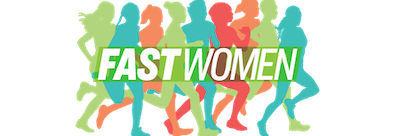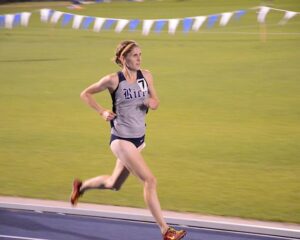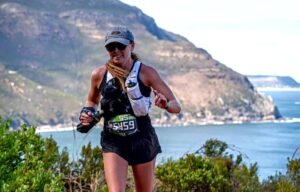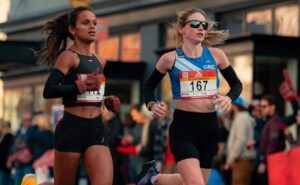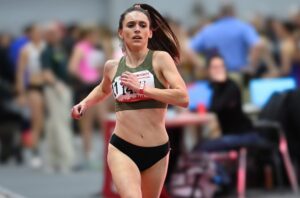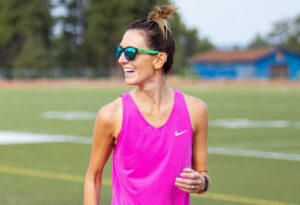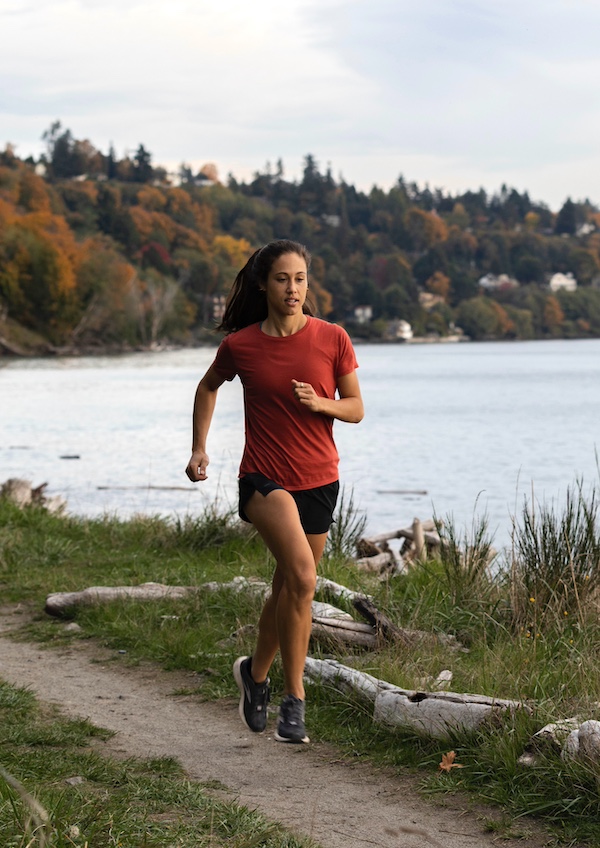
Justine Fédronic, 34, first used running as a way to connect with other kids. She was born in Germany to a French-Caribbean father and Hungarian mother. She lived in France until age six, when her family moved to California. No one in her family spoke English at the time, but chasing her classmates on the playground at recess did not require much talking.
During middle school, Fédronic’s PE teachers recognized her talent and encouraged her to go out for the track team. She rarely attended practice, but by eighth grade, she could break 60 seconds in the 400m. A high school coach saw her run and encouraged her parents to have her go out for cross country in ninth grade. He explained to them that college is expensive in the U.S., but running could be her ticket to an athletic scholarship.
Fédronic wanted to play volleyball, but on the first day of high school cross country practice, her parents decided she was going. “My dad actually dragged me in the car, kicking and screaming, and I cried,” Fédronic told Fast Women. She enjoyed aspects of the experience more than she expected, though. Her team became a second family, and as a highly competitive person, winning was addictive.
Fédronic’s success came quickly, but so did the injuries. In her first season of running, she had three bone stress injuries, and that kicked off an injury cycle that would last through the end of her professional running career. “One of the things I was blessed with, which was part of my downfall, too, is that I’m really responsive to training,” she said. “So I get back in shape really fast, and I’d start competing probably before my body was ready. I had a well-meaning high school coach who was really excited to coach us, but I don’t know that we had all the information and guidance that would have been good for my long-term health and development.”
In retrospect, Fédronic believes she was struggling with REDs, but the term had not yet been coined. She was also anemic, but she didn’t have a lot of nutritional guidance, and she had no idea she was underfueling for her level of activity.
In spite of it all, Fédronic had a highly successful high school career and went on to Stanford, where the mix of success and injuries continued. It didn’t help that she had a different coach nearly every year she was at Stanford, and they couldn’t always figure out where she fit into the training as a cross country runner who was also on the 4x400m relay. “At no point in my college career did I think that the situation I was in was not good for me,” she said. “I was just really driven to get better and wanted to trust whatever coaches were telling me to do.”
Sometimes that meant training and racing through injuries. She remembers doing a workout before regionals one year and limping between reps, but her coaches didn’t want her to get an MRI, in case it showed something that would take her out for the season. “As you have some space from your career, you start to digest some things and realize that they were not okay,” she said. “But at the time, you normalize them, because you have to.”
Fédronic also dealt with significant mental health struggles while she was at Stanford, but she didn’t feel like telling anyone was an option. She finds it encouraging that the current generation of young athletes have felt safer opening up about their experiences.
During her fourth year, Chris Miltenberg, who is now at UNC, took over the program, and his conservative coaching style was a good fit for her. “I just needed consistency at that point,” she said. “I don’t think we ever did anything really hard at practice, but the only magic in running, really, is just stacking decent days. I remember at one point feeling like I could beat anyone. And to have someone who was excited by my practice performances and positive had a big influence on me, because some of my previous experiences were more fear-based.”
That spring, she PRed by two seconds in the 800m at the 2013 NCAA Championships and finished third, and suddenly professional running was a possibility. She wasn’t a U.S. citizen at the time, so she began looking into representing France. Soon after, she was racing at the Paris Diamond League meet, where she ran a personal best of 2:00.97.
Fédronic returned to Stanford for a fifth year, and in her final college race, she was hoping to anchor her team to a win in the distance medley relay at the 2014 NCAA Indoor Championships, but she was outkicked by Arkansas’ Dominique Scott and finished second. Few people knew it at the time, but Fédronic was racing with a fractured rib. “They would just slap a Lidoderm patch on me,” she said. “I was in so much pain, but my team was really counting on me. It was a really mixed bag of emotions.”
Fédronic had no outdoor eligibility remaining, so she began running professionally during her final semester at Stanford. While she was performing well, she was still running through injury. And being a U.S.-based French athlete was lonely at times. Her coaches and training partners were often working off of a different schedule, and she attended many meets solo.
After college, she moved to Eugene, Oregon, to join Team Run Eugene, which was coached by Ian Dobson. She enjoyed the training environment, and it’s where she met her fiancé, Isaac Updike, though they didn’t start dating until her pro career was over. But most of the time she was in Eugene, she was rehabbing a torn hamstring. When the physical therapist she was working with got hired by the Brooks Beasts, she began making regular trips to Seattle to work with him.
At the time, the Beasts’ coach, Danny Mackey, also coached some non-Brooks athletes. He offered to work with her, so at the end of 2015, she moved to Seattle. She remembers her last workout before leaving Eugene. She ran 4 x 800m at 6:00 pace, and it was a major struggle.
Mackey and Fédronic had their work cut out for them, but his coaching was a good fit for her. “We did a lot of athletic work and drills and mechanics, and I lifted for real for the first time. No one had ever taught me how to lift before,” she said. She broke 2:00 for the first time, running 1:59.86, finished second at the French Championships, and made the 2016 Olympic team. “That was a really quick turnaround from being in absolutely miserable condition in December to making an Olympic team,” she said.
But the experience was still very lonely at times. When she competed at France’s Olympic Trials, It felt like everyone else was there with an entourage, while she just had her grandmother in the stands, plus members of her club team, who she did not see often. Two days before the meet, her knee swelled up. But by then, she had become a pro at racing through pain.
Fédronic remained injured during the buildup to the Games. By the time she arrived on the starting line in Rio, the longest continuous run she could do was 15 minutes. She finished fifth in her opening round heat, running 2:02.73.
“It was really bittersweet,” she said. “I was also in an unhealthy relationship at the time and experiencing some things in parallel. It was a really difficult period of my life. I think we all build this up in our heads, like if you do the thing that everyone says you should be aiming for, you’re going to be happy, you’re going to be financially secure. But after the Games, I was just exhausted and depressed, and now I had a multitude of other health stuff to heal.”
Nike began sponsoring Fédronic in the summer of 2014, but as a European athlete, she made significantly less than her American coaches thought she would. She was racing in Diamond League meets and some of the contract offers she received were around $10,000. Nike is also known for its reduction clauses, which hit her hard as an injury-prone athlete. Because she was hurt for most of 2015, her contact was reduced by 50 percent. Leading up to the Olympics, she had roughly $500 in savings, which added to her stress.
In 2017, Fédronic had a good indoor season, but Nike chose not to take her option year. “All of a sudden, I was in this position where I was an Olympian, I had PRed indoors, and I had no income from running,” she said.
Though she was training with a Brooks-sponsored team, the brand was not interested in signing her. She had income and support from Roka, the eyewear brand, in 2017, but for the remainder of her professional career, she was unsponsored. She loved the athletes she was training with, but it was difficult and disheartening to train alongside them with much less support.
“My driver was that I still really wanted it and I thought I could do it, and it was worth it because of that,” she said. “But I think that’s where these layers of exhaustion started to come in.”
Throughout her professional running career, Fédronic worked part-time jobs to help make ends meet. She nannied and babysat, coached, worked as a fitness model, worked at a tea shop, was a receptionist at a gym, taught kindergarten STEM and trained adults to do the same, she took on writing gigs, and made commissioned wood art, among other things.
The more she had to work, the harder it was to make her schedule fit with the team’s training. In 2020, while teaching others about design thinking and how if things don’t work, you adjust, she realized she wasn’t doing that in her own life. “I decided to [test out] not going to practice,” she said. “I think it surprised everyone at the time, because I’d actually had a good training block. And I think no one really believed me.”
Once she gave herself permission to step away from the all-encompassing lifestyle of a professional athlete, she felt much lighter. She initially thought she might just take the 2020 season off, while races were canceled due to Covid, but she found that her heart wasn’t fully in it anymore. And then she was rear-ended while driving twice in two weeks and got a serious concussion, which was challenging but “helped rip the Band-Aid off” by forcing her to take a step back.
For a while, she wanted nothing to do with the sport. “I just felt like I had to heal my heart and mind,” she said. “We all love this sport so much and there were some really beautiful times, but it is a rollercoaster of heartbreak and joy. And, for me, not having the resources was exhausting.”
But being in a relationship with a fellow athlete and having close friends who were still competing eventually brought her back. “The first time I went to a track meet again, I walked into the hotel lobby in Eugene, saw all the agents, and had a panic attack,” she said. “I hadn’t told anyone I had retired and people were just confused. They figured I was hurt again. I had to run away and go cry on a random street in Eugene.”
Now she tries to be the support person for others that she wishes she had had during her career. “Isaac has this longevity in his career because he has a much more relaxed approach to everything than I did,” she said. “Sometimes it’s really jarring for me to be with his family and friends in the stands, because they have this unconditional awe and love for him. If he doesn’t make a team, immediately they’re like, ‘Wow, we’re so proud of him for trying.’ And I didn’t necessarily have that experience at all. The expectation was that if you’re going to do this, you have to be world class at it or you’re wasting your time.”
Fédronic estimates that she now runs about eight miles a week and exercises mostly so that she can keep up with her active friends on weekends. She says she never really loved continuous running, so now she often does what she calls “stride walks,” alternating between doing strides and walking for recovery, to satisfy her desire to run quickly.
“I just try to reconnect to how my running felt when I was a kid and I was running on the playgrounds and the joy of having power and strength in your own body and being outside and seeing beautiful things.”
Fédronic retired from professional running partially so she could save her relationship with the sport and enjoy it on her own terms. “There are a lot of versions of running that are all equally valid,” she said. “And I think when we’re deep in it, we sometimes forget that. For so many years, I took great pride in being known as tough, gritty and resourceful, which meant that I often held myself to those standards even when they weren’t in my best interest.
“I think for a long time I conflated pivoting with giving up. I ‘retired’ from one version of my running and pivoted to a version that serves me in a happier, healthier way. Do I still think I had untapped potential? Absolutely. But that’s okay.”
Fédronic also wanted to retire before she did too much damage to her body. Her father was a professional figure skater, which wore down his joints. She wanted to avoid suffering a similar fate. Now she has no desire to push herself through pain, and she’s gone from being extremely competitive to feeling like she doesn’t need to prove herself athletically in any way.
Since retiring, Fédronic has remained involved in the sport professionally. She has worked as an arts and culture coordinator for Janji for several years. From 2023 to 2024, she served as Oiselle’s community and athlete partnerships manager, and most recently, she has taken over as the community impact and partnerships manager for For All Mothers+. She sees it as an opportunity to do better by the current generation of athletes. “We’re creating this new era of sport where an athlete is respected for being a full human being,” she said, “and creating a path that’s more sustainable and empowering than what we had.”

